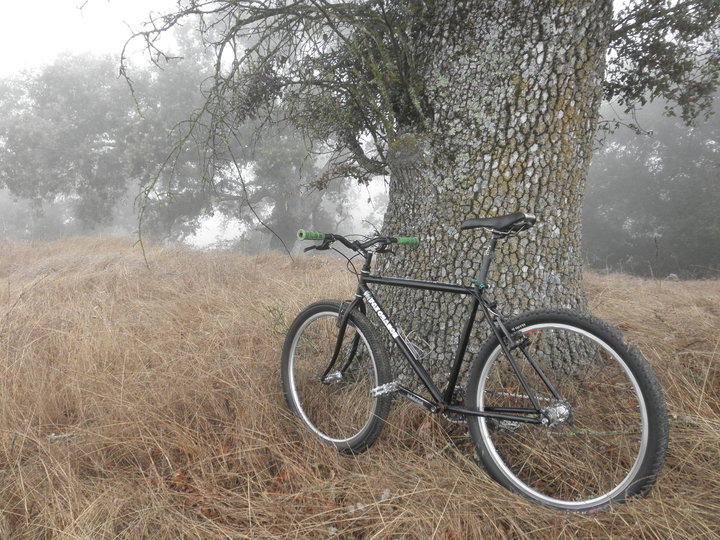
I used to ride with a dude (we’ll call him Candice) who only touched rigid singlespeeds. He owned two; one geared for flat commuting and one geared for trail use. Both were custom built by Sycip Cycles and if, like me, you despair over the influx of Chinese plastic bikes, take a look at what Sycip is up to and you’ll feel better about the world. Anyway, Candice did own a beautiful full suspension Ventana but never rode it. He said it was too heavy (from someone well past 100kg), was too complicated to set up and had no soul. He’d go on about the raw, visceral feeling of sending some skinny, steel tubing with some wheels into a hideous, rock-strewn, baby head section at speed which somehow identified him as a purist. He also gave no thought to pairing camo with tie-dye, was a huge fan of Genesis and, much like Prog Rock, some of his stories would last for 15 minutes and make no sense at all. Candice then, a little leftfield and a lot sartorially challenged. What about the rigid though? Is this the type of person who comes to mind when the word is uttered? Can a rigid bike be cool these days, and if so should you add one to the fleet?
There seems to be a subconscious connection between shredding and suspension and if you ride a bike without it, it’s clear you’re not interested in speed, traction, control, getting air or comfort, and you may as well ride a cross/gravel/road/recumbent. I’ll tell you a little secret, it’s not all about suspension! Some of the most epic rides I’ve had were aboard my 1980s Wicked Fat Chance rigid. Really though, I was much younger and it was more about hanging on and hoping as a passenger rather than being in any sense of control. But I do understand where Candice is coming from. I like the idea of no pivots to service, no fork stanchions to scratch, the simple distilled essence of riding. But there must be a better way and, happily, there is.
The great thing about a trusty trail bike is that, unlike Enduro or DH, a trail build can be anything you want because it’s not about transition stages or choosing a bike with the most travel that you can still pedal uphill, or how many bottomless tokens you run. A trail bike can have big wheels or small wheels, hardtail or full sus. It should be set up to reflect the local trails and terrain you dig riding. A trail bike can even be rigid. The recipe is simple: preferably steel with big tyres on wide hoops. Now, wheels. I promised myself I wouldn’t utter the F word in this piece because I didn’t want to alienate you, (or myself any further)… but, seriously, if you haven’t tried a plus sized bike or ummm, something bigger in rigid form, you’re denying yourself a massive, ear to ear, shit eating, feel like you’re 8, huge tooth-bearing smile. And if you’re not gurning like an idiot after the test ride around the carpark, invoice me for your time and I’ll compensate you for reading this far*.

I recall an article by a certain Mr. Dangerfield who decided to sell their full sus rig and go the long travel hardtail route for a year to see if their riding improved without any rear squish dumbing down the experience. I liked the idea so when it came time to add a modern geared hardtail to my fleet there were any number of ways I could have gone. I vascillated much about which hardtail and platform was for me. I went (DAMMIT!) fat and pulled the trigger on a budget sled I’d be able to upgrade if I liked it. 18 months later and I’m happy to report it’s been sold, to fund a much, much better one. I have quite literally gone to the Dark Side and honestly, the grass couldn’t be greener. For starters, the grip that can be had from a 4″ tyre at 8psi on a fast, loose, off-camber corner is just astonishing. Couple that with the fact it’s rolling on 26″ rims with the outside tyre diameter of a 29er on a light, rigid chassis with a 67 degree head angle and it beggars belief.
It’s the sort of bike that flatters you and brings with it a false sense of security because it doesn’t ride like a rigid. Truthfully, it doesn’t ride like anything you’ve ever ridden before. There are utterances from suspension manufactures about how their new fork/coating/damper increases small bump sensitivity while still offering solid pedalling efficiency. Yeah. The fatty doesn’t so much absorb bumps as it just flattens them out and there is so much compliance in the tyre that it completely offsets any noticeable rolling resistance. Its confidence-inspiring stability at speed lulls you into going faster and picking hairier lines, until of course you bottom the tyre on the rim careering over a rock which the full sus would have easily absorbed. Line choice is totally different but despite this, it is an incredibly capable bike. More capable than I have space in this to tell you about, so go see for yourself. So you definitely need one, is it cool though?
No. Not even close. Not in a thousand years will anyone look cool on a fat bike. I imagine that roadies cycling past shop windows like to think they look like Marco Pantani. I don’t. I don’t ride through town, ever. It’s good training actually because I have to take a huge detour to get home from my preferred trailhead which is awesome, because I get to spend just a bit more time with my new favourite bike.
*Compensation not actual or valid.



Leave a Reply